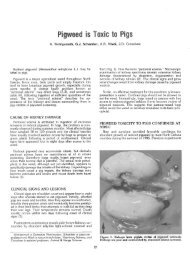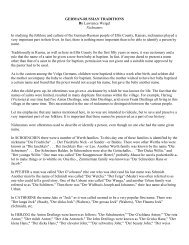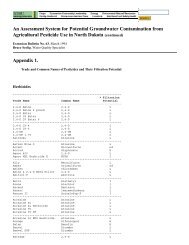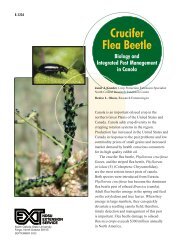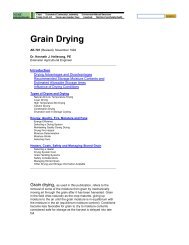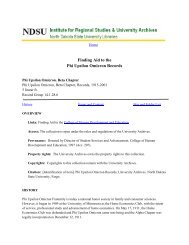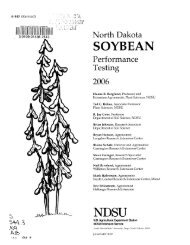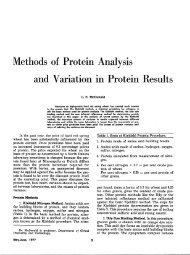Yield Mapping and Use of Yield Map Data
Yield Mapping and Use of Yield Map Data
Yield Mapping and Use of Yield Map Data
- No tags were found...
Create successful ePaper yourself
Turn your PDF publications into a flip-book with our unique Google optimized e-Paper software.
A yield frequency map depicting acorn <strong>and</strong> soybean rotation in Illinoisin a five-year period (from Franzen,2008). Each individual year did notshow all <strong>of</strong> these patterns. Meaningfullong-term trends in yield were revealedwith accompanying relationshipsto soil phosphorus, potassium <strong>and</strong>pH (acidity or alkalinity) levels onlyfollowing the combination <strong>of</strong> years.in the exact same manner. In this way, two years, threeyears or 20-plus years <strong>of</strong> data can be combined tocreate a more meaningful yield frequency map.The yield frequency map has been used as a zonelayer for revealing residual soil nitrate <strong>and</strong> other nutrientsin North Dakota. The yield frequency map also can helpreveal areas that require additional management, suchas a change in nitrogen application timing or a change indrainage if permitted. It can reveal the yield drag due tohedgerows, saline spots, compacted areas or locationscontaining harmful levels <strong>of</strong> sodium.The yield frequency map also can be usedconceivably to predict the relative performance <strong>of</strong> farms<strong>and</strong> evaluate future production potential for renting orpurchasing decisions. If the soils on a farm that youmanage have a certain level <strong>of</strong> productivity, this potentialproductivity probably also is possible on farms withinseveral miles <strong>of</strong> that farm. This information can helpdetermine whether a farm is worth renting or buying.The yield maps are a valuable archive <strong>of</strong> fi eldperformance <strong>and</strong> the changes that management mighthave had on the fi elds. These archived maps <strong>and</strong> datacan be shared with bankers to help secure loans <strong>and</strong>with future renters or purchasers <strong>of</strong> the l<strong>and</strong>. They canbe passed down to the next generation so that the thingsgrowers learn about their fi elds will not be lost to theheirs.Many growers also use a yield monitor to helpdevelop nutrient strategies on specifi c farms. Differentrates <strong>of</strong> nitrogen, for example, can be applied in stripsacross soils within a fi eld, <strong>and</strong> the yields can help thegrower determine what the best rate might be for a soilor the fi eld. In addition, new products can be tested ona small strip within the fi eld <strong>and</strong> the effi cacy <strong>of</strong> their use<strong>Yield</strong> frequencymap at Williston,N.D. (top), withlower yields onthe ridge slope(southeast tonorthwest direction)<strong>and</strong> higher yieldin the more levelareas above <strong>and</strong>below the ridgeslope (southwest<strong>and</strong> northeast)(elevation image onthe bottom).can be much more easily seen this way than by using aweigh wagon. The many data points <strong>of</strong> each strip alsolend themselves to the use <strong>of</strong> statistics <strong>of</strong>fered withinspreadsheets to provide confi dence to the growerthat the differences seen were statistically real or not.Variability within a fi eld can mask differences or createdifferences unless statistics are used to help eliminatethe clutter.ReferencesSuddoth, 2007. <strong>Yield</strong> editor s<strong>of</strong>tware. USDA-ARS. www.ars.usda.gov/services/s<strong>of</strong>tware/download.htm?s<strong>of</strong>twareid=20Franzen, 2008. Summary <strong>of</strong> forty years <strong>of</strong> grid sampling in twoIllinois fi elds. NDSU Technical Report.The NDSU Extension Service does not endorse commercial productsor companies even though reference may be made to tradenames,trademarks or service names.This publication may be copied for noncommercial, educational purposesin its entirety with no changes. Requests to use any portion <strong>of</strong> thedocument (including text, graphics or photos) should be sent to NDSU.permission@ndsu.edu. Include exactly what is requested for use <strong>and</strong>how it will be used.For more information on this <strong>and</strong> other topics, see: www.ag.ndsu.eduCounty commissions, North Dakota State University <strong>and</strong> U.S. Department <strong>of</strong> Agriculture cooperating. North Dakota State University does not discriminateon the basis <strong>of</strong> race, color, national origin, religion, sex, disability, age, Vietnam Era Veterans status, sexual orientation, marital status, or public assistancestatus. Direct inquiries to the Vice President for the Division <strong>of</strong> Equity, Diversity <strong>and</strong> Global Outreach, 205 Old Main, (701) 231-7708. This publication will bemade available in alternative formats for people with disabilities upon request, (701) 231-7881.1M-12-08



